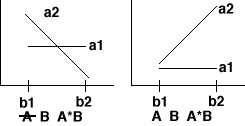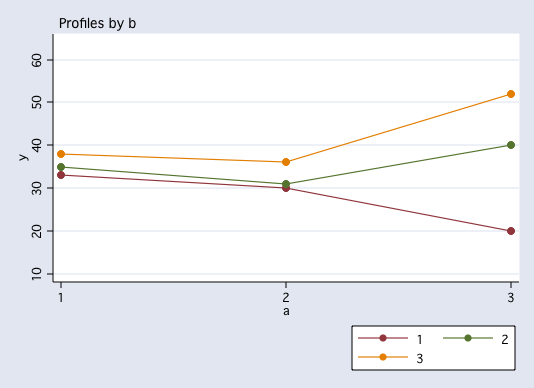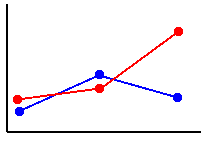

Interactions Defined
Graphs of Means of Hypothetical 2x2 Factorial Designs
No Interactions


Interactions


Interactions Take Precedence over Main Effects
When Interactions are Significant
Consider this 3 Factor Example
A main effect sig B main effect sig C main effect ns A*B interaction ns A*C interaction ns B*C interaction sig A*B*C interaction nsOr this 4 Factor Example
A main effect sig B main effect sig C main effect ns D main effect sig A*B interaction ns A*C interaction ns A*D interaction ns B*C interaction sig B*D interaction sig C*D interaction sig A*B*C interaction ns A*B*D interaction ns B*C*D interaction sig A*B*C*D interaction nsInterpreting Interactions
Graph of Cell Means from the 3x3 Factorial Example

Tests of Simple Main Effects
Source SS df MS F A 190.00 2 95.00 1.52 n.s. B 1543.33 2 771.67 12.35 sig. A*B 1236.67 4 309.17 4.95 sig B at a1 63.33 2 31.67 0.51 n.s. B at a2 103.33 2 51.67 0.83 n.s. B at a3 2613.33 2 1306.67 20.91 sig. Wcell 2250.00 36 62.50 Total 5220.00 44
Tests of Simple Main Effects in Stata
use http://www.philender.com/courses/data/crf33, clear
anova y a b a#b
Number of obs = 45 R-squared = 0.5690
Root MSE = 7.90569 Adj R-squared = 0.4732
Source | Partial SS df MS F Prob > F
-----------+----------------------------------------------------
Model | 2970 8 371.25 5.94 0.0001
|
a | 190 2 95 1.52 0.2324
b | 1543.33333 2 771.666667 12.35 0.0001
a#b | 1236.66667 4 309.166667 4.95 0.0028
|
Residual | 2250 36 62.5
-----------+----------------------------------------------------
Total | 5220 44 118.636364
sme b a
Test of b at a(1): F(2/36) = .50666667
Test of b at a(2): F(2/36) = .82666667
Test of b at a(3): F(2/36) = 20.906667
Critical value of F for alpha = .05 using ...
--------------------------------------------------
Dunn's procedure = 4.0941238
Marascuilo & Levin = 4.5974255
per family error rate = 4.5974255
simultaneous test procedure = 6.5295994
anovalator b a, simple fratio
anovalator test of simple main effects for b at(a=1)
chi2(2) = 1.0133333 p-value = .60250057
scaled as F-ratio = .50666667
anovalator test of simple main effects for b at(a=2)
chi2(2) = 1.6533333 p-value = .43750521
scaled as F-ratio = .82666667
anovalator test of simple main effects for b at(a=3)
chi2(2) = 41.813333 p-value = 8.324e-10
scaled as F-ratio = 20.906667
Follow Up with Pairwise Comparisons at a3
tkcomp b if a==3
Tukey-Kramer pairwise comparisons for variable b
studentized range critical value(.05, 3, 36) = 3.4569115
mean
grp vs grp group means dif TK-test
-------------------------------------------------------
1 vs 2 20.0000 40.0000 20.0000 5.6569*
1 vs 3 20.0000 52.0000 32.0000 9.0510*
2 vs 3 40.0000 52.0000 12.0000 3.3941
anovalator b, pair at(a=3) fratio
Adjusted predictions Number of obs = 45
Expression : Linear prediction, predict()
at : a = 3
b (asbalanced)
------------------------------------------------------------------------------
| Delta-method
| Margin Std. Err. z P>|z| [95% Conf. Interval]
-------------+----------------------------------------------------------------
b |
1 | 20 3.535534 5.66 0.000 13.07048 26.92952
2 | 40 3.535534 11.31 0.000 33.07048 46.92952
3 | 52 3.535534 14.71 0.000 45.07048 58.92952
------------------------------------------------------------------------------
anovalator pairwise comparisons for b at(a=3)
Comparison Coef. Std. Err. z P>|z| [95% Conf. Interval]
1 vs 2 -20 5 -4 0.000 -29.8 -10.2
1 vs 3 -32 5 -6.4 0.000 -41.8 -22.2
2 vs 3 -12 5 -2.4 0.016 -21.8 -2.2Regression using anovalator
regress y a##b
Source | SS df MS Number of obs = 45
-------------+------------------------------ F( 8, 36) = 5.94
Model | 2970 8 371.25 Prob > F = 0.0001
Residual | 2250 36 62.5 R-squared = 0.5690
-------------+------------------------------ Adj R-squared = 0.4732
Total | 5220 44 118.636364 Root MSE = 7.9057
------------------------------------------------------------------------------
y | Coef. Std. Err. t P>|t| [95% Conf. Interval]
-------------+----------------------------------------------------------------
a |
2 | -3 5 -0.60 0.552 -13.14047 7.14047
3 | -13 5 -2.60 0.013 -23.14047 -2.85953
|
b |
2 | 2 5 0.40 0.692 -8.14047 12.14047
3 | 5 5 1.00 0.324 -5.14047 15.14047
|
a#b |
2 2 | -1 7.071068 -0.14 0.888 -15.34079 13.34079
2 3 | 1 7.071068 0.14 0.888 -13.34079 15.34079
3 2 | 18 7.071068 2.55 0.015 3.65921 32.34079
3 3 | 27 7.071068 3.82 0.001 12.65921 41.34079
|
_cons | 33 3.535534 9.33 0.000 25.8296 40.1704
------------------------------------------------------------------------------
anovalator b a, main 2way fratio
anovalator main-effect for b
chi2(2) = 24.693333 p-value = 4.344e-06
scaled as F-ratio = 12.346667
anovalator main-effect for a
chi2(2) = 3.04 p-value = .21871189
scaled as F-ratio = 1.52
anovalator two-way interaction for b#a
chi2(4) = 19.786667 p-value = .00055023
scaled as F-ratio = 4.9466667
anovalator b a, simple fratio
anovalator test of simple main effects for b at(a=1)
chi2(2) = 1.0133333 p-value = .60250057
scaled as F-ratio = .50666667
anovalator test of simple main effects for b at(a=2)
chi2(2) = 1.6533333 p-value = .43750521
scaled as F-ratio = .82666667
anovalator test of simple main effects for b at(a=3)
chi2(2) = 41.813333 p-value = 8.324e-10
scaled as F-ratio = 20.906667
Consider the Following Plot of Cell Means

Would you need to do tests of simple main effects?
Would you need to follow up tests of simple main effects with pairwise comparisons?
Pooling
Philosophies on Pooling
Pooling
Simplified Pooling Example
Step 1: Without Pooling Source SS df MS F A 45 3 15.00 1.875 p>.05 B 72 4 18.00 2.250 p>.05 A*B 5 12 .42 <1 n.s. Wcell 800 100 8.00 Total 922 119 Step 2: With Pooling Source SS df MS F A 45 3 15.00 2.11 p>.05 B 72 4 18.00 2.50 p<=.05 Error 805 112 7.19 Total 922 119
A More Complex Example of Pooling
Step 1: Without Pooling
Source
A
B
C
A*B
A*C
B*C
A*B*C
Wcell
Total
Step 2: Pool Highest Order Interaction
Source
A
B
C
A*B
A*C
B*C
Error = Wcell + A*B*C
Total
Step 3: Pool All Interactions
Source
A
B
C
Error = Wcell + A*B*C + A*B + A*C + B*C
Total
Pooling in Stata
Pooling in Stata can be accomplished simply leaving the appropriate interactions terms out of the anova command.
anova y a b c a#b a#c b#c a#b#c /* no pooling */ anova y a b c a#b a#c b#c /* pool a*b*c */ anova y a b c /* pool a*b a*c b*c a*b*c */Interaction Example in a 3 Factor Model
use http://www.philender.com/courses/data/threeway, clear
anova y a##b##c
Number of obs = 24 R-squared = 0.9689
Root MSE = 1.1547 Adj R-squared = 0.9403
Source | Partial SS df MS F Prob > F
-----------+----------------------------------------------------
Model | 497.833333 11 45.2575758 33.94 0.0000
|
a | 150 1 150 112.50 0.0000
b | .666666667 1 .666666667 0.50 0.4930
a#b | 160.166667 1 160.166667 120.13 0.0000
c | 127.583333 2 63.7916667 47.84 0.0000
a#c | 18.25 2 9.125 6.84 0.0104
b#c | 22.5833333 2 11.2916667 8.47 0.0051
a#b#c | 18.5833333 2 9.29166667 6.97 0.0098
|
Residual | 16 12 1.33333333
-----------+----------------------------------------------------
Total | 513.833333 23 22.3405797

 anovalator b c, 2way at(a=1) fratio
anovalator two-way interaction for b#c at(a=1)
chi2(2) = 30.5 p-value = 2.382e-07
scaled as F-ratio = 15.25
anovalator b c, 2way at(a=2) fratio
anovalator two-way interaction for b#c at(a=2)
chi2(2) = .375 p-value = .82902912
scaled as F-ratio = .1875
anovalator c, main at(a=1 b=1) fratio
anovalator main-effect for c at(a=1 b=1)
chi2(2) = 48 p-value = 3.775e-11
scaled as F-ratio = 24
anovalator c, main at(a=1 b=2) fratio
anovalator main-effect for c at(a=1 b=2)
chi2(2) = 1 p-value = .60653066
scaled as F-ratio = .5
anovalator c, pairwise at(a=1 b=1) fratio
Adjusted predictions Number of obs = 24
Expression : Linear prediction, predict()
at : a = 1
b = 1
c (asbalanced)
------------------------------------------------------------------------------
| Delta-method
| Margin Std. Err. z P>|z| [95% Conf. Interval]
-------------+----------------------------------------------------------------
c |
1 | 11 .8164966 13.47 0.000 9.399696 12.6003
2 | 15 .8164966 18.37 0.000 13.3997 16.6003
3 | 19 .8164966 23.27 0.000 17.3997 20.6003
------------------------------------------------------------------------------
anovalator pairwise comparisons for c at(a=1 b=1)
Comparison Coef. Std. Err. z P>|z| [95% Conf. Interval]
1 vs 2 -4 1.1547 -3.46 0.001 -6.263213 -1.736787
1 vs 3 -8 1.1547 -6.93 0.000 -10.26321 -5.736787
2 vs 3 -4 1.1547 -3.46 0.001 -6.263213 -1.736787
tkcomp c if a==1 & b==1
Tukey-Kramer pairwise comparisons for variable c
studentized range critical value(.05, 3, 12) = 3.772768
mean
grp vs grp group means dif TK-test
-------------------------------------------------------
1 vs 2 11.0000 15.0000 4.0000 4.8990*
1 vs 3 11.0000 19.0000 8.0000 9.7980*
2 vs 3 15.0000 19.0000 4.0000 4.8990*
anovalator b c, 2way at(a=1) fratio
anovalator two-way interaction for b#c at(a=1)
chi2(2) = 30.5 p-value = 2.382e-07
scaled as F-ratio = 15.25
anovalator b c, 2way at(a=2) fratio
anovalator two-way interaction for b#c at(a=2)
chi2(2) = .375 p-value = .82902912
scaled as F-ratio = .1875
anovalator c, main at(a=1 b=1) fratio
anovalator main-effect for c at(a=1 b=1)
chi2(2) = 48 p-value = 3.775e-11
scaled as F-ratio = 24
anovalator c, main at(a=1 b=2) fratio
anovalator main-effect for c at(a=1 b=2)
chi2(2) = 1 p-value = .60653066
scaled as F-ratio = .5
anovalator c, pairwise at(a=1 b=1) fratio
Adjusted predictions Number of obs = 24
Expression : Linear prediction, predict()
at : a = 1
b = 1
c (asbalanced)
------------------------------------------------------------------------------
| Delta-method
| Margin Std. Err. z P>|z| [95% Conf. Interval]
-------------+----------------------------------------------------------------
c |
1 | 11 .8164966 13.47 0.000 9.399696 12.6003
2 | 15 .8164966 18.37 0.000 13.3997 16.6003
3 | 19 .8164966 23.27 0.000 17.3997 20.6003
------------------------------------------------------------------------------
anovalator pairwise comparisons for c at(a=1 b=1)
Comparison Coef. Std. Err. z P>|z| [95% Conf. Interval]
1 vs 2 -4 1.1547 -3.46 0.001 -6.263213 -1.736787
1 vs 3 -8 1.1547 -6.93 0.000 -10.26321 -5.736787
2 vs 3 -4 1.1547 -3.46 0.001 -6.263213 -1.736787
tkcomp c if a==1 & b==1
Tukey-Kramer pairwise comparisons for variable c
studentized range critical value(.05, 3, 12) = 3.772768
mean
grp vs grp group means dif TK-test
-------------------------------------------------------
1 vs 2 11.0000 15.0000 4.0000 4.8990*
1 vs 3 11.0000 19.0000 8.0000 9.7980*
2 vs 3 15.0000 19.0000 4.0000 4.8990*
Linear Statistical Models Course
Phil Ender, 17sep10, 12Feb98